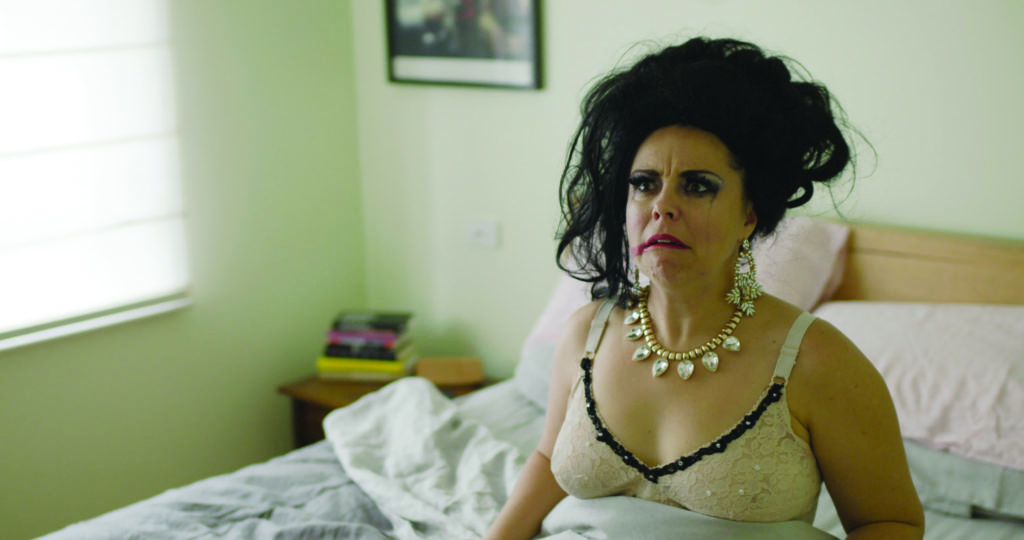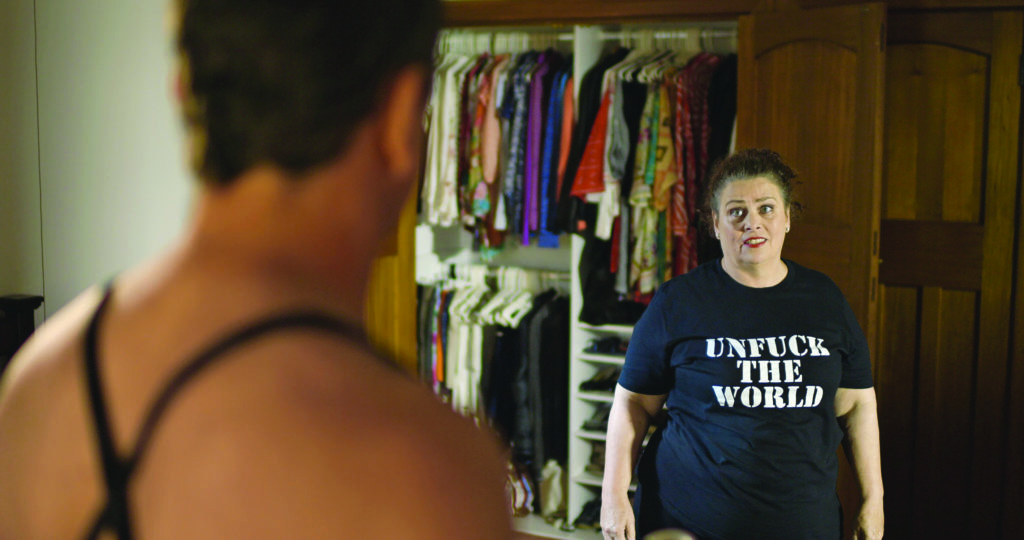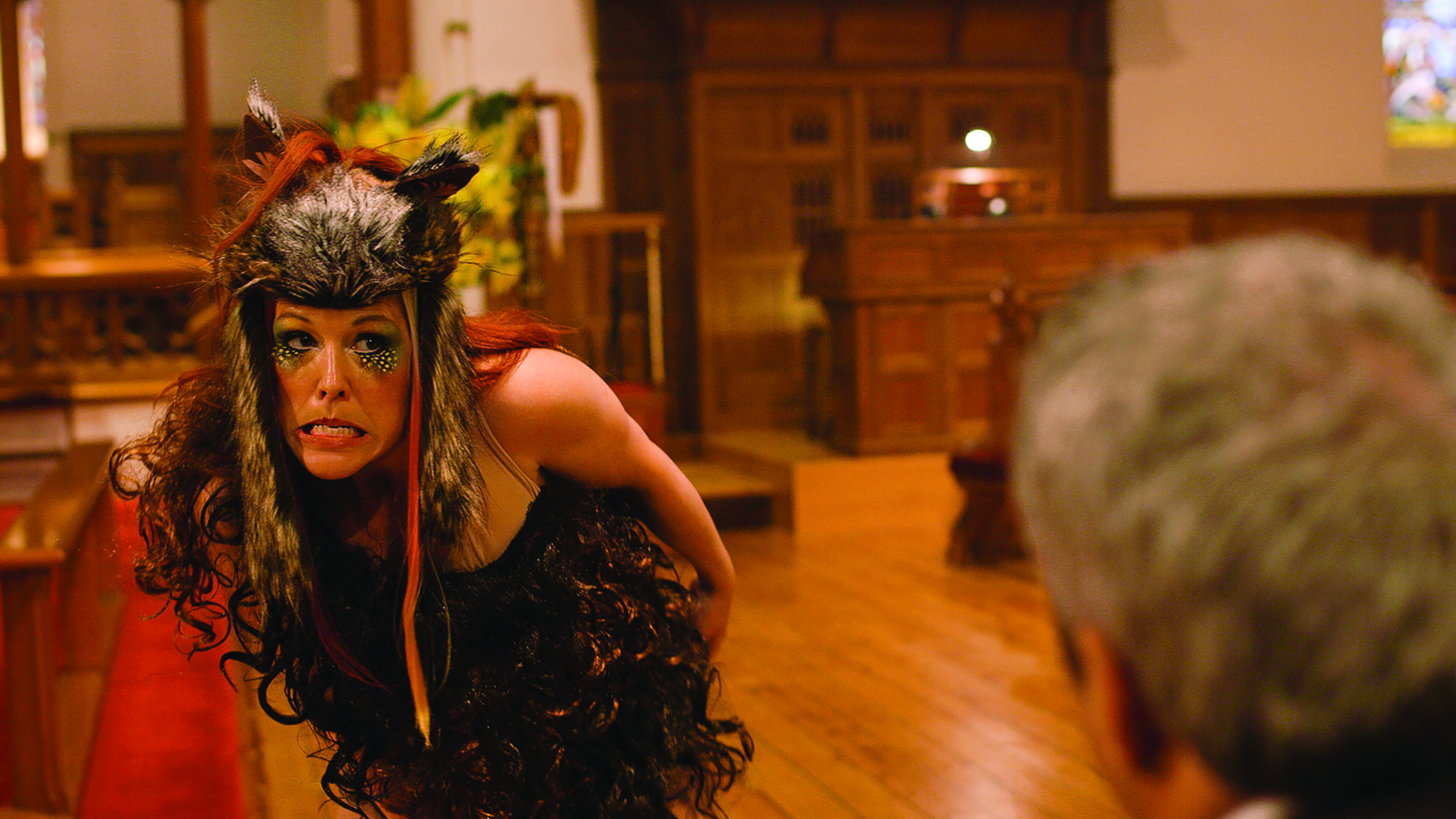What would happen if you used Mike Leigh’s rehearsal process to bring to life a Miranda July project that channelled the renegade, independent spirit of the New Queer Cinema of the 1990s? Chances are it would end up bearing more than a passing resemblance to The Five Provocations (Angie Black, 2018). Until now, the film has screened almost exclusively at film festivals, including the Melbourne Queer Film Festival and Lorne Film; but it has since been picked up by Label Distribution, and was scheduled to be released on multiple streaming services in late September. Audiences will be able to watch The Five Provocations through iTunes, Google Play and Vimeo.
While this is writer/director Black’s first feature, the film’s inclusive lens and emphasis on the experiences of social outsiders resonates with her body of short-film work. Senior lecturer in narrative film at the Victorian College of the Arts, Black has a particular interest in performance approaches within film production. She has been designated part of a contemporary ‘Australian new wave’ of independent filmmakers who are producing formally innovative work.[1]Bill Mousoulis, ‘The Australian New Wave’, Pure Shit: Australian Cinema, <www.pureshitauscinema.com/new_wave.html>, accessed 14 August 2020. Her independent production company, Black Eye Films, was established in 1999 with the aim of supporting the promotion and visibility of women and gender-diverse people on screen and behind the camera.[2]See ‘Bio’, Black Eye Films, <www.blackeyefilms.com.au>, accessed 18 June 2020.

This mission statement is evident in The Five Provocations, which features an authentic, ‘lived-in’ sensibility and an ensemble of characters that includes the type of protagonists who are not often depicted on Australian screens. What is particularly appealing in the film is its resistance to presenting an outsider’s gaze; rather than an emphasis on the dislocation between the protagonists and their sociocultural environments, here the perspective is reframed so that heteronormativity is displaced in favour of a kind of ‘homonormativity’. Within Black’s (highly unstable) diegesis, the characters’ sexuality and gender identities sit comfortably within their inner-city Melbourne environments as an almost incidental detail. For a queer audience, there is a real comfort to this mode of representation and the visibility it enables. Beyond this, however, there is a far broader notion of queerness that arguably underpins the film’s experimental methodology.
The Five Provocations is predicated on transgressive experimentation: it actively sets out to disrupt stable categories of performance, narrative and form. It is almost as though Black ‘queers’ the film form, presenting us with a subversive narrative structure that merges cinematic conventions with the dynamic immediacy of the live performance space. This particular iteration of what constitutes a queer text is celebratory, a site of transformation; here, a refusal to follow the rules is richly rewarded.
The film’s radical rehearsal process meant that Black had to relinquish conventional writer/director control over the development of both character and narrative. She stepped into what she refers to as ‘the fear space’, finding a freedom in resisting conventions:
If you don’t try and fit into the conventions it allows you the freedom to be truly creative […] Being within a system means you are stifling the creative process because it doesn’t allow you to take risks.[3]Angie Black, quoted in Anna Dzenis, ‘The Five Provocations: Interview with Angie Black’, screenhub, 19 February 2019, <https://www.screenhub.com.au/news-article/news/film/anna-dzenis/the-five-provocations-interview-with-angie-black-257326>, accessed 1 May 2020.
Despite being very much an ensemble piece, The Five Provocations was initially conceived within the framework of a one-to-one dialogue between director and actor. Black worked with her actors over a two-year period, improvising plausible backstories that would later be developed into a series of overlapping lives. Each actor remained completely in the dark about the broader project their role would contribute to. Due to the unique logic that governed the film’s conception, it’s likely that even Black was unaware of how the narrative threads would come together right up until the final cut.
The film that formally brings together such freewheeling, disparate elements is surprisingly cohesive, accessible and entertaining. It tracks the lives of four characters who are each responding to very personal measures of grief and loss. The narrative is divided into five chapters: the first four each take up the perspective of a different character, while the fifth, ‘Forgiveness’, brings the previous four together and provides a closure of sorts.
The narrative throughline is provided by Marlena (Sapidah Kian), who is mourning the death of her secret lover, Rosie (Lisa Garner). Rosie’s widowed husband, Paul (Tony Moclair), is unaware that the women were more than platonic friends. He is busy raising daughter Queenie (Olive Black) while coming to terms with both the loss of his wife and the reality of his own role as an absent husband. When Marlena advertises for a lodger, aimless Bridget (Rebecca Bower) seems to fit the bill; however, a positive pregnancy test poses challenges for the latter, disarmingly kooky young woman. Meanwhile, plumber Clinton (Blake Osborn) must navigate his evolving gender identity.

The characters’ stories are momentarily ruptured by the unexpected imposition of a ‘provocation’ – each one provided by a different Australian cabaret performer[4]The five provocations are performed (in order of appearance) by Maude Davey, as Woman in Fur; Sarah Ward, as Yana Alana; Amanda Morris, as Mother Creature; Gabi Barton and Carla Yamine, as Cunt Head 1 and 2; and Steven Gray, as Sarah Pax. who recreates one of their own previous works. The performance registers range from absurd to poignant to melancholy; each is calibrated to speak to the circumstances of a particular character, and to provoke them into dealing head-on with questions of grief, guilt, repression or uncertainty. For the actors, the inexplicable imposition of the provocateurs is just as unexpected as it is for the audience. Diegetic continuity is radically compromised as the performers commandeer the screen space; here, the camera mediates discordant modes of performance as well as competing functions of ‘audience’. Fascinatingly, the camera’s eye is simultaneously the recorder of a performance for an audience of one and the conduit between the film audience and an imagined live audience. Black explains the rationale underpinning the provocations’ sudden emergence into their respective scenes:
The character onscreen had to be as surprised by the performance pieces as an audience would be. For this reason I decided to conceal these performances from the actor. I called these performance scenes ‘provocations’ because they were specifically chosen to trigger suppressed emotions in the character. The five provocations in the film not only capture authentic reactions but also explore each of the emotional responses to provocation.[5]Angie Black, ‘Director’s Statement’, The Five Provocations website, <http://www.thefiveprovocations.com>, accessed 14 August 2020.
Due to this essential element of surprise, Black had just one take to capture each of the actors’ ‘in-character’ reactions to the provocations. This dynamic relay between improvisation, ‘live’ performance, filmed performance and cinematic spectatorship further ‘queers’ the film form. It’s perhaps here that we get the truest sense of The Five Provocations as an experimental work rich in queer possibilities. Interestingly, the modality of touch brings in a haptic connection that blurs the categories of viewer and viewed, performance and performer.
The idea of a transgressive space that doesn’t follow any discernible rules is central to the work of the performance artists featured in The Five Provocations.
The film opens with a dream memory that emphasises touch: the film form takes on an embodied register as indistinct images of trees and lush grasses invite us to sense rather than view as they make sensuous contact with our skin. The film enacts a kind of material provocation, at once romantic and wistful, that prefigures the later material eruption of the provocateurs. We see Marlena and Rosie in intimate close-up, hands entwined, the little contours of their skin dominating the image. The gentle rhythm of the sequence and the sound of trees whispering augment this tactile register as the figurative is displaced by a haptic modality. As film and media scholar Laura U Marks puts it,
Haptic looking tends to move over the surface of its object rather than to plunge into illusionistic depth, not to distinguish form so much as to discern texture. It is more inclined to move than to focus, more inclined to graze rather than to gaze.[6]Laura U Marks, The Skin of the Film: Intercultural Cinema, Embodiment, and the Senses, Duke University Press, Durham, NC & London, 2000, p. 162.
This tactile address establishes the role of touch within the narrative (from Marlena’s painful memories of her secret relationship with Rosie through to the frenetic, embodied performances of the provocateurs). It also nods to a kind of reshuffling of the senses; with the imposition of each provocation, the actor may well need to disregard the kind of conventional thinking associated with objective ‘vision’ and to lean on alternate senses to guide their reactions. Touch is also invoked to replicate the physically charged atmosphere of the live cabaret space, with its often visceral ‘contact’ between performer and audience. This is established with the first provocative eruption, in which Marlena takes the hand of Maude Davey’s enigmatic ‘distraught woman’ character. A close-up of their clasped hands seems to beckon us along for the ride, effectively collapsing the space between the different planes of spectatorship. Black explains that she wanted to test the limits of this connection:
With a lot of live performance what you get as an audience member is surprise and fear and the feeling that you’re on the edge, not really sure where the work is going to go, and whether there is going to be some audience participation that is going to terrify you deeply. There is a very alive and electric vibe in live performance work and I wondered whether you could really capture that for the screen.[7]Black, quoted in Dzenis, op. cit.

The idea of a transgressive space that doesn’t follow any discernible rules is central to the work of the performance artists featured in The Five Provocations. At times, this subversive aesthetic even bleeds into the film’s narrative, providing a kind of meta-commentary on the dynamic process of creation. In one particularly memorable dinner sequence, Bridget demonstrates a ‘laughing circle’ for Marlena and Dutch (Steven Gray), whose reactions mirror those of the viewer, moving from bemusement to uncontrollable laughter. She explains that the idea is to first feign laughter in order to summon the real thing, a kind of living application of ‘fake it till you make it’. Bridget’s absurdly physical machinations as she convulses in a parody of laughter reinforce an idea of artificiality; Black externalises the performance process in order to interrogate its limitations. It is as though we are observing a rehearsal technique that has been turned in on itself or reduced to an abstraction. Just like the extradiegetic eruptions of the provocateurs, here Bridget’s performance momentarily transforms the film form, and the effect registers in the bodies of her immediate ‘audience’ as well as in the bodies of the viewing audience. It’s a kind of contagion of hilarity that delightfully subverts both theatrical and cinematic conventions.
The Five Provocations asks radical questions about the rehearsal process, script development, style, aesthetics, narrative, performance and even the role of the director. It’s a testament to Black’s skill and the commitment and talent of her cast that the film coheres into a thoroughly engaging whole.
http://thefiveprovocations.com
Endnotes
| 1 | Bill Mousoulis, ‘The Australian New Wave’, Pure Shit: Australian Cinema, <www.pureshitauscinema.com/new_wave.html>, accessed 14 August 2020. |
|---|---|
| 2 | See ‘Bio’, Black Eye Films, <www.blackeyefilms.com.au>, accessed 18 June 2020. |
| 3 | Angie Black, quoted in Anna Dzenis, ‘The Five Provocations: Interview with Angie Black’, screenhub, 19 February 2019, <https://www.screenhub.com.au/news-article/news/film/anna-dzenis/the-five-provocations-interview-with-angie-black-257326>, accessed 1 May 2020. |
| 4 | The five provocations are performed (in order of appearance) by Maude Davey, as Woman in Fur; Sarah Ward, as Yana Alana; Amanda Morris, as Mother Creature; Gabi Barton and Carla Yamine, as Cunt Head 1 and 2; and Steven Gray, as Sarah Pax. |
| 5 | Angie Black, ‘Director’s Statement’, The Five Provocations website, <http://www.thefiveprovocations.com>, accessed 14 August 2020. |
| 6 | Laura U Marks, The Skin of the Film: Intercultural Cinema, Embodiment, and the Senses, Duke University Press, Durham, NC & London, 2000, p. 162. |
| 7 | Black, quoted in Dzenis, op. cit. |





